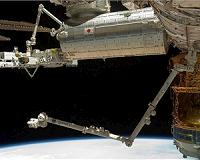 |
El Segundo CA (SPX) Mar 29, 2011 The first Reentry Breakup Recorder (REBR), an instrument designed and constructed by engineers at The Aerospace Corporation, is set to plunge to Earth on March 29, shortly after 7 p.m. Two REBRs were carried to the International Space Station (ISS) onboard a Japanese Kounotori2 spacecraft, also known as the HTV2, on Jan. 21. The REBR is a small autonomous device that is designed to record temperature, acceleration, rotation rate, and other data as a spacecraft reenters Earth's atmosphere. The REBRS will be attached to spacecraft returning to Earth from the ISS and will take measurements as the spacecraft breaks up during its reentry. The first REBR remained on the HTV2 and will make measurements during the spacecraft's return to Earth. The second REBR was moved by astronauts aboard the ISS to the Automated Transfer Vehicle-2 (ATV-2), a European Space Agency (ESA) unmanned vehicle launched Feb. 16 to deliver supplies to the ISS. The second REBR will make measurements aboard the ATV-2 during its reentry this summer. As the spacecraft reenter the atmosphere, they will begin to break apart. Simultaneously, the REBRs will begin collecting data - ultimately detaching from the disintegrating spacecraft and continuing their fall. Dr. Bill Ailor, director of Aerospace's Center for Orbital and Reentry Debris Studies and REBR development team leader, said that the REBR will be in freefall at approximately 60,000 feet. "It will make a phone call to Earth and have about five minutes to send its data before it lands in the Pacific Ocean." While the REBR is not designed to withstand the impact of striking the ocean, the recorder contains a GPS device that will allow scientists to know its landing location. Ailor notes that hazards associated with the reentries of space hardware have always been limited by a lack of information on what hardware actually survives the reentry process to hit the ground, and the response of the hardware to the reentry environment. "Hardware fragments can hit the ground anywhere along a footprint that is hundreds of miles long. Except for the Columbia accident, when the shuttle disintegrated over Texas during reentry into Earth's atmosphere, fewer than 250 fragments are known to have been recovered over the past 40 years, and only a very few of these fragments have been examined in detail," said Ailor. "Excluding the Columbia accident, virtually no useful telemetry has ever been received," Ailor added. "Since nearly 75 percent of Earth's surface is water, much of the reentered debris falls in water and is never seen." REBR was integrated and flown under the direction of the Department of Defense's Space Test Program. Its heat shield was designed and fabricated by the Boeing Company.
Share This Article With Planet Earth
Related Links - Station at NASA Station and More at Roscosmos S.P. Korolev RSC Energia Watch NASA TV via Space.TV Space Station News at Space-Travel.Com
 Data Streaming In From Space Station To OSU Lab
Data Streaming In From Space Station To OSU LabCorvallis, OR (SPX) Mar 29, 2011 A prototype scanner aboard the International Space Station has been taking new images of Earth's coastal regions during the 16 months since it was launched, providing scientists with a new set of imaging tools that will help them monitor events from oil spills to plankton blooms. The images and other data are now available to scientists from around the world through an online clearinghouse ... read more |
|
| The content herein, unless otherwise known to be public domain, are Copyright 1995-2010 - SpaceDaily. AFP and UPI Wire Stories are copyright Agence France-Presse and United Press International. ESA Portal Reports are copyright European Space Agency. All NASA sourced material is public domain. Additional copyrights may apply in whole or part to other bona fide parties. Advertising does not imply endorsement,agreement or approval of any opinions, statements or information provided by SpaceDaily on any Web page published or hosted by SpaceDaily. Privacy Statement |